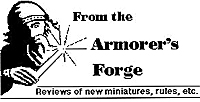 by Charles C. Sharp
by Charles C. Sharp
I purchased this interesting book from George Nafziger at Advance the Colors '99. George is well known to many Great Lakes members, as he has supported the chapter for several years and has been a dealer at Advance the Colors since its inception in 1996. George authors and publishes a variety of military history books, with orders of battle being a particular specialty. Charles Sharp is well known to many historical gamers, as he has authored numerous articles in various wargaming publications; he also wrote the extensive 12-volume Soviet Order of Battle WWII, also published by George Nafziger.
As the title implies, this book describes the tactics employed by German panzer units, from the platoon to the regiment. The book is arranged chronologically, with organizational information, including tank strength, for armored formations for each major campaign: Poland 1939; France 1940; North Africa 1941-42; Russia 1941, 1942 and 1943; and Western Europe 1944. The actual tactics used by the German armored forces are described in the training directives issued to the troops. The baseline document is the training directive dated March 1, 1939, which sets forth the tactical instructions which the armored forces were expected to follow. Accompanying this document is a set of diagrams showing prescribed tank formations for platoons, companies, and battalions.
The evolution of the tactics employed by German panzer forces is described in numerous "lessons learned" sections, each written after the major campaigns. I found these lessons learned to be the most interesting portions of the book. For instance, the combat experience report from the 3rd Panzer Brigade after the 1940 campaign describes the relative combat performance of the German tanks as opposed to the French and British tanks which the brigade encountered during the campaign. The experiences of several units are quoted in a similar section describing the German panzers' encounters with the T-34 and KV tanks during 1941. A report from the 24th Panzer Division describes the unit's experiences with street fighting during the battle for Stalingrad. The author provides commentary on many of these tactical reports, which complements them nicely.
The introduction of heavy tanks into the panzer arsenal is covered as well. A training directive dated May 20, 1943, describes the tactical employment of the Tiger tank companies, and is accompanied by diagrams showing several prescribed formations. This is followed by a summary of panzer tactics at the Battle of Kursk, with an emphasis on the tactics used to fight the massed Soviet anti-tank guns at the battle, written by Colonel von Mellenthin of the 48th Panzer Corp.
A September, 1944, report describes how the German heavy tanks adapted their tactics to deal with the heavy Soviet "Josef Stalin" tanks. Along with this article, the author has included reports from several Soviet officers describing the methods they used against the German Tiger tanks. Finally, the combat experiences of the panzers during the Normandy campaign highlight the steps taken to guard against allied air superiority.
A consistent theme throughout the book is how German tactics evolved to deal with superior enemy tanks, particularly early in the war, and how combined arms tactics were emphasized. As a wargamer, I found the book to be very enlightening. I highly recommend this book to anyone interested in the German tank forces of World War II. (Published by George Nafziger, 1998. Format 8 1/2 x 11, softcover, 101 pages).
Back to The Herald 32 Table of Contents
Back to The Herald List of Issues
Back to MagWeb Master Magazine List
© Copyright 1999 by HMGS-GL.
This article appears in MagWeb (Magazine Web) on the Internet World Wide Web. Other military history articles and gaming articles are available at http://www.magweb.com